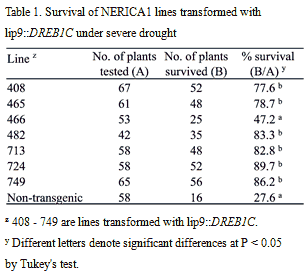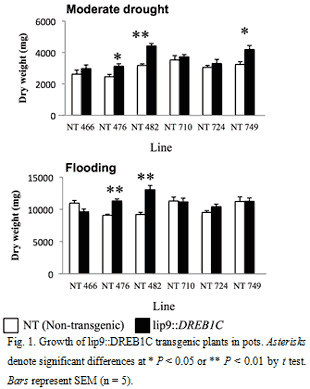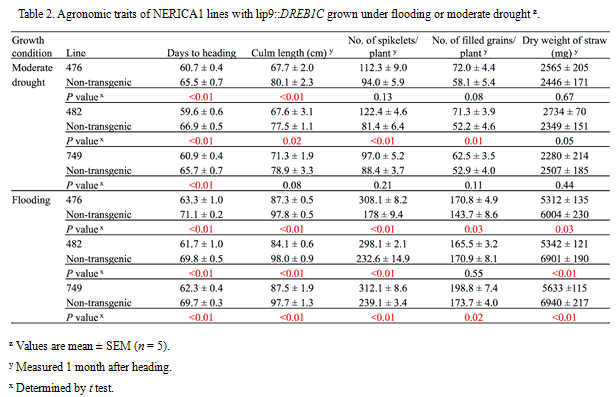Improvement of drought resistance of upland New Rice for Africa (NERICA) by expression of DREB1C
Description
The demand for rice in Africa is increasing, and the need to improve rice production is urgent. In this context, one group of cultivars, called New Rice for Africa (NERICA), has become the focus of high expectations, and is becoming increasingly popular in Africa. Since the majority of rice production in Africa relies on rainfall, drought resistance is one of the most important traits for further improvement. The dehydration-responsive-element–binding protein 1 (DREB1) gene is one of the best-characterized candidate genes for conferring tolerance to abiotic stresses, including drought. Here, we introduced Arabidopsis DREB1C under the control of a stress-inducible rice lip9 promoter (lip9::DREB1C) into NERICA1, which is one of the most popular upland NERICA cultivars. We investigated survival under severe drought, and vegetative growth performance and several agronomic traits under moderate drought.
The constructs, lip9::DREB1C, was introduced into NERICA1 by Agrobacterium-mediated transformation. T3 plants carrying the transgene as a single homozygous copy were used for analysis. We evaluated the ability of plants to survive under rapid drying. Seeds were sown on soil in 50-mL conical tubes with a hole at the bottom (1 seed/tube), and the tubes were immersed in water. After 3 weeks, tubes with plants were taken out of the water and left unwatered for 10 days. The withering plants were then returned to water, and their recovery was recorded 1 week later. The survivors were considered to be the plants that were expanding new leaves. Transgenic lines had greater survival than the non-transgenic plants (Table 1). We also investigated the growth of plants under long-term moderate drought. Fourteen-day-old seedlings were planted on saturated soil in 4-L pots and then the soil was allowed to dry naturally. When the volumetric content dropped below about 15%, we added enough water to keep it at around 15%. Control plants were grown in permanently flooded soil. Each pot held 2 transgenic plants and 2 non-transgenic plants for comparison. First, we measured dry weight at the late vegetative growth stage (2 months old). The transgenic plants tended to have higher dry weights under moderate drought than non-transgenic plants, and 3 of those differences were significant (Fig. 1). Then we replanted transgenic lines 476, 482, and 749, which had higher shoot dry weights than non-transgenic plants under moderate drought, to investigate heading time, number of spikelets, number of filled grains, and dry weight of straw. All 3 transgenic lines headed significantly earlier than non-transgenic plants (Table 2). The culm length of transgenic plants was significantly shorter than that of non-transgenic plants in most cases. Transgenic plants tended to have more spikelets per plant (an indicator of sink capacity) and more filled grains per plant (an indicator of yield ability) than non-transgenic plants under moderate drought, line 482 significantly so. Under flooding, all 3 transgenic lines had significantly more spikelets than non-transgenic plants, and lines 476 and 749 also had significantly more filled grains than non-transgenic plants. Transgenic plants had significantly less straw than non-transgenic plants under flooding.
We demonstrated that DREB1C improves both drought resistance and traits relating to yield of NERICA1. In the case of successful field trials, the selected transgenic lines can be potentially used in a number of arid regions in Africa.
Figure, table
- Affiliation
-
Japan International Research Center for Agricultural Sciences Tropical Agriculture Research Front
- Classification
-
Administration A
- Research project
- Program name
- Term of research
-
FY 2012 (FY 2011-FY 2015)
- Responsible researcher
-
Ishizaki Takuma ( Tropical Agriculture Research Front )
Maruyama Kyounoshin ( Biological Resources and Post-harvest Division )
Obara Mitsuhiro ( Biological Resources and Post-harvest Division )
Fukutani Akeyo ( Biological Resources and Post-harvest Division )
Shinozaki Kazuko ( Biological Resources and Post-harvest Division )
ORCID ID0000-0002-0249-8258Ito Yusuke ( Biological Resources and Post-harvest Division )
Kumashiro Takashi ( Biological Resources and Post-harvest Division )
- ほか
- Publication, etc.
-
Ishizaki et al. (2013) Molecular Breeding 31: 255-264
- Japanese PDF
-
2012_11_A4_ja.pdf75.63 KB
- English PDF
-
2012_11_A4_en.pdf318.11 KB



